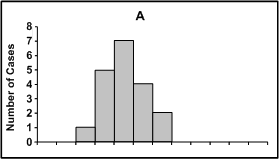Key points
- Epidemiologic curves can help investigators understand more about an outbreak.
- Use the resources below to collect information relevant to identifying etiologies of respiratory outbreaks.
- Do not use the below forms to report outbreaks to CDC.

Epidemiological curve
Epidemiological curves or "epi curves" can shed light on whether
- An outbreak is most likely due to a point source or person-to-person transmission
- An outbreak is increasing or waning
- The pathogen has a long or short incubation period
Create an epi curve
Create an epi curve using the generate an epi curve template.
The template consists of an Excel file with two worksheets. Entering information into the first worksheet (Case Data) will automatically construct an epi curve in the second worksheet (Epi Curve). The resulting histogram will illustrate the number of cases of respiratory disease over time.
Step 1: Click on the Case Data tab at the bottom of the workbook. Replace the generic dates ("Date 1", etc.) with the range of illness onset dates for the cases. Enter the number of cases in the row and column that corresponds with the appropriate illness onset date and case classification category.
Categories include:
- Confirmed cases (column B)
- Probable cases (column C)
- Suspect cases (column D)
Step 2: Click on the Epi Curve tab at the bottom of the workbook to see the graph automatically populated. Make changes by right clicking on the graph and selecting the appropriate option or by changing data in the Case Data worksheet.
Get information on interpretting an epi curve:
Data collection forms
Use the resources below to collect information relevant to identifying etiologies of respiratory outbreaks.
Long form
The data collection—long form provides a comprehensive set of questions to consider using when developing a case questionnaire.
These questions cover a range of topic areas including:
- Patient and family contact information
- Occupation
- Travel history and other exposures of interest
- Extensive past medical history review
- A comprehensive list of potential laboratory tests completed
It would be unusual to use the long form in its entirety for any particular outbreak. Instead, use pieces of the form based on factors surrounding the outbreak, including the differential diagnoses and the population affected.
Information needed to answer many of the questions on the long form may not be available. In addition, investigators may need to compile information from several sources, such as:
- Medical records
- Physician, patient, and family interviews
- Public health partners
Short form
The data collection—short form collects common or "core" data elements needed in most respiratory disease outbreak investigations. Modify the form as necessary to accommodate the particular data requirements of the current outbreak investigation.
The first page of the form allows for collecting the following from a patient interview:
- Basic demographics
- Symptoms
- Exposure information
The second page collects objective clinical and laboratory testing information. You can collect this information by interviewing the treating or reporting physician or by reviewing the ill person's medical record.
